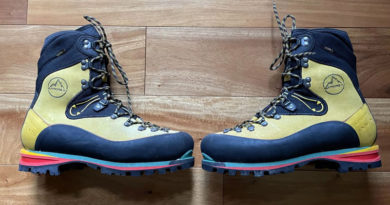La Sportiva Tarantulace vs. Tarantula Climbing Shoes
Climbing shoes are an essential piece of equipment for any rock climber. They provide grip and support on the rock surface, allowing climbers to ascend steep inclines with ease. When it comes to choosing the right climbing shoes, there are many options available on the market. Two popular choices from La Sportiva are the Tarantulace and Tarantula climbing shoes.
While both shoes have similar names and designs, there are some key differences between them. The Tarantulace is a lace-up shoe with a leather and synthetic upper, while the Tarantula is a velcro-strapped shoe with an all-synthetic upper. Each shoe also has a unique sole and fit, which can affect performance and comfort on the rock.
In this article, I will compare these shoes, explore their similarities and differences, and help you determine which shoe may be the best fit for your climbing needs.
La Sportiva Tarantulace
Climbing Shoe Type: Neutral
Last: Slip-lasted
Upper: Leather/microfiber
Lining: 1.8 mm LaspoFlex
Outsole: 5 mm FriXion RS rubber
Footwear Closure: Single-pull Lace
Weight (Pair): 1 lb. 1.2 oz.
Climbers love the La Sportiva Tarantulace climbing shoe for its comfortable fit and versatility. It’s a lace-up shoe with a leather and synthetic upper that offers a snug fit and allows for customization via the lacing system. The Tarantulace’s ability to perform well in a variety of climbing scenarios, from indoor bouldering to outdoor sport climbing, is one of its advantages. The FriXion RS rubber sole provides excellent traction on a variety of surfaces, making it appropriate for slab and steep climbing.
One disadvantage of the Tarantulace is that the leather upper can stretch over time, requiring readjusting the laces for a better fit. This is especially aggravating for climbers who rely on a precise fit to perform at their best. Furthermore, the leather upper may not breathe as well as a synthetic upper, resulting in sweaty feet and unpleasant odors. Another disadvantage is that the shoe may not be appropriate for climbers with high arches. The fit around the midfoot may be too tight, causing discomfort and pain while climbing.
Overall, the La Sportiva Tarantulace climbing shoe is a reliable and versatile choice for climbers of all levels. While it may have some downsides, such as stretching and limited breathability, these can be mitigated with proper care and attention to fit. The Tarantulace remains a popular choice for climbers looking for a comfortable and versatile shoe that performs well in a range of climbing scenarios.
What I like: Affordable, flat midsole is comfortable all day, well-balanced performance across many areas
What I don’t: Insensitive, imprecise fit, ineffective design for steep terrain
See the La Sportiva Tarantulace
La Sportiva Tarantula
Climbing Shoe Type: Neutral
Last: Slip-lasted
Upper: Leather
Lining: Not specified
Outsole: 5 mm FriXion RS
Footwear Closure: Strap
Weight (Pair): 1 lb. 4.5 oz.
Climbers who value comfort and ease of use will appreciate the La Sportiva Tarantula climbing shoe. It has Velcro straps and an all-synthetic upper, making it easy to put on and take off. The Velcro straps provide a snug fit that is comfortable for prolonged climbing sessions. One of the Tarantula’s advantages is its adaptability. It is appropriate for both indoor and outdoor climbing, including bouldering and sport climbing. The FriXion RS rubber sole provides excellent traction on a variety of surfaces, making it a reliable shoe for climbers of all skill levels.
The Tarantula’s all-synthetic upper, on the other hand, may not breathe as well as a leather upper. This can result in sweaty feet and unpleasant odors, especially when climbing for long periods of time. Furthermore, the Velcro straps may wear out and need to be replaced over time. Another disadvantage is that the shoe may not fit as precisely as a lace-up shoe. This is especially important for climbers who need a precise fit for peak performance. While Velcro straps provide a secure fit, they are not as adjustable as laces.
Overall, the La Sportiva Tarantula climbing shoe is a comfortable and versatile choice for climbers of all levels. While it may have some downsides, such as limited breathability and potential strap wear, these can be mitigated with proper care and attention to fit. The Tarantula remains a popular choice for climbers who prioritize comfort and ease of use.
What I like: A good shoe for beginners.
What I don’t: The shoe has a shorter lifespan and it wears out quickly.
Conclusion
In conclusion, the La Sportiva Tarantulace and Tarantula climbing shoes are both popular choices among climbers for their reliable performance and comfort. The Tarantulace features a leather and synthetic upper and a lace-up design that provides a customizable fit, while the Tarantula has an all-synthetic upper and a velcro-strapped design that makes it easy to put on and take off.
Both shoes are versatile and suitable for a range of climbing scenarios, from indoor bouldering to outdoor sport climbing. The FriXion RS rubber sole provides excellent grip on various surfaces, making them a reliable choice for climbers of all levels.
While both shoes have their strengths, they also have their downsides. The Tarantulace may stretch over time and may not be suitable for climbers with high arches, while the Tarantula may not breathe as well as a leather upper and may not provide as precise a fit as a lace-up shoe.
Ultimately, the choice between the two comes down to personal preference and fit. It’s important to try on both shoes and determine which one feels more comfortable and provides better support for your individual climbing needs. Regardless of which shoe you choose, both are reliable options that can help you climb your best.






